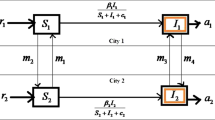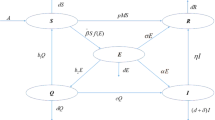Abstract
We develop, in this paper, a reaction–diffusion epidemic model with the general incidence rate and personal protection awareness, where, the direct transmission and indirect transmission are also introduced to describe the complexity of the spread of infectious diseases. The existence, uniqueness and boundedness of global solution are obtained first. And then, the basic reproduction number \({\mathcal {R}}_{0}\) is derived to go as the threshold value for predicting the persistence and extinction of disease. To be more specific, model admits a globally asymptotically stable disease-free steady state if \({\mathcal {R}}_{0}<1\), while the disease is persistent for \({\mathcal {R}}_{0}>1\). Further, for \({\mathcal {R}}_{0}=1\), the global asymptotic stability of the disease-free steady state is demonstrated when all diffusion coefficients are constants. In addition, the global asymptotical stability of the endemic equilibrium of this model with spatially homogeneous is derived if the corresponding basic reproduction is great than 1. Particularly, we also discuss the existence of traveling wave solution and the minimum wave speed \(c^{*}\) of the spatial homology model. Numerical simulations are presented to validate the main results and provide some recommendations for the control of multi-transmission diseases.






Similar content being viewed by others
References
Tien, J.H., Earn, D.J.D.: Multiple transmission pathways and disease dynamics in a waterborne pathogen model. Bull. Math. Biol. 72, 1506–1533 (2010)
Eisenberg, M.C., Robertson, S.L., Tien, J.H.: Identifiability and estimation of multiple transmission pathways in cholera and waterborne disease. J. Theor. Biol. 324, 84–102 (2013)
Masud, M.A., Islam, M.H., Kim, B.N.: Understanding the role of environmental transmission on COVID-19 herd immunity and invasion potential. Bull. Math. Biol. 84, 116 (2022)
Song, C.W., Xu, R., Song, N., et al.: Global dynamics and optimal control of a cholera transmission model with vaccination strategy and multiple pathways. Math. Biosci. Eng. 17, 4210–4224 (2020)
Memarbashi, R., Mahmoudi, S.M.: A dynamic model for the COVID-19 with direct and indirect transmission pathways. Math. Biosci. Eng. 44, 5873–5887 (2021)
Li, M.T., Jin, Z., Sun, G.Q., et al.: Modeling direct and indirect disease transmission using multi-group model. J. Math. Anal. Appl. 446, 1292–1309 (2017)
Yuan, X.Y., He, D.H., Wang, J.L., et al.: A zika endemic model for the contribution of multiple transmission routes. Bull. Math. Biol. 83, 111 (2021)
Yuan, Y.R., Yuan, N.L.: Optimal control and cost-effectiveness analysis for a COVID-19 model with individual protection awareness. Phys. A 603, 127804 (2022)
Gondim, J.A.M.: Preventing epidemics by wearing masks: an application to COVID-19. Chaos Solitons Fract. 143, 110599 (2021)
Kobe, J., Pritchard, N., Short, Z., et al.: A game-theoretic model of Cholera with optimal personal protection strategies. Bull. Math. Biol. 80, 2580–2599 (2018)
Chen, F.H.: On the transmission of HIV with self-protective behavior and preferred mixing. Math. Biosci. 199, 141–159 (2006)
Zheng, T.T., Nie, L.F.: Modelling the transmission dynamics of two-strain Dengue in the presence awareness and vector control. J. Theor. Biol. 443, 82–91 (2018)
Hu, L., Nie, L.F.: Dynamic modeling and analysis of COVID-19 in different transmission process and control strategies. Math. Methods Appl. Sci. 44, 1409–1422 (2021)
Kassa, S.M., Ouhinou, A.: The impact of self-protective measures in the optimal interventions for controlling infectious diseases of human population. J. Math. Biol. 70, 213–236 (2015)
Mezouaghi, A., Djillali, S., Zeb, A., et al.: Global proprieties of a delayed epidemic model with partial susceptible protection. Math. Biosci. Eng. 19, 209–224 (2022)
Martcheva, M.: An Introduction to Mathematical Epidemiology. Springer, New York (2015)
Zhao, X.Q.: Dynamical Systems in Population Biology, 2nd edn. Springer, Cham (2017)
Cantrell, R.S., Cosner, C.: Spatial Ecology via Reaction–Diffusion Equations. Wiley, Hoboken (2003)
Allen, L.J.S., Bolker, B.M., Lou, Y., et al.: Asymptotic profiles of the steady states for an SIS epidemic reaction–diffusion model. Discrete Contin. Dyn. Syst. 21, 1–20 (2008)
Magal, P., Webb, G.F., Wu, Y.X.: On the basic reproduction number of reaction–diffusion epidemic models. SIAM J. Appl. Math. 79, 284–304 (2019)
Yang, Y., Zou, L., Zhou, J.L., et al.: Dynamics of a waterborne pathogen model with spatial heterogeneity and general incidence rate. Nonlinear Anal. RWA 53, 103065 (2020)
Tu, Y.B., Meng, X.Z., Gao, S.J., et al.: Dynamics and strategies evaluations of a novel reaction–diffusion COVID-19 model with direct and aerosol transmission. J. Frankl. Inst. 359, 10058–10097 (2022)
Cai, Y.L., Kang, Y., Malay, M., et al.: Complex dynamics of a host-parasite model with both horizontal and vertical transmissions in a spatial heterogeneous environment. Nonlinear Anal. RWA 40, 444–465 (2018)
Zhou, J.L., Yang, Y., Zhang, T.H.: Global dynamics of a reaction–diffusion waterborne pathogen model with general incidence rate. J. Math. Anal. Appl. 466, 835–859 (2018)
Zhang, X.Y., Zhang, Y.X.: Spatial dynamics of a reaction–diffusion cholera model with spatial heterogeneity. Discrete Contin. Dyn. Syst. Ser. B 23, 2625–2640 (2018)
Anderson, R.M., May, R.M.: Population biology of infectious diseases: part I. Nature 280, 361–367 (1979)
Kumar, A.: Nilam: stability of a time delayed SIR epidemic model along with nonlinear incidence rate and Holling type-II treatment rate. Int. J. Comput. Methods 15, 1850055 (2018)
Dubey, B., Dubey, P., Dubey, U.S.: Dynamics of an SIR model with nonlinear incidence and treatment rate. Appl. Appl. Math. 10, 718–737 (2015)
Upadhyay, R.K., et al.: Dynamics of an SEIR epidemic model with nonlinear incidence and treatment rates. Nonlinear Dyn. 96, 2351–2368 (2019)
Lou, Y.J., Zhao, X.Q.: A reaction-diffusion malaria model with incubation period in the vector population. J. Math. Biol. 62, 543–568 (2011)
Smith, H.L.: Monotone Dynamical Systems: An Introduction to the Theory of Competitive and Cooperative Systems. American Mathematical Society, Providence (1995)
Martin, R.H., Smith, H.L.: Abstract functional differential equations and reaction–diffusion systems. Trans. Am. Math. Soc. 321, 1–44 (1990)
Guo, Z.M., Wang, F.B., Zou, X.F.: Threshold dynamics of an infective disease model with a fixed latent period and non-local infections. J. Math. Biol. 65, 1387–1410 (2012)
Groeger, J.: Divergence theorems and the supersphere. J. Geom. Phys. 77, 13–29 (2014)
Guenther, R.B., Lee, J.W.: Partial Differential Equations of Mathematical Physics and Integral Equations. Dover Publications, New York (1996)
Wang, M.: Nonlinear Elliptic Equations. Science Press, Beijing (2010)
Wu, J.H.: Theory and Applications of Partial Functional Differential Equations. Springer, New York (1996)
Hale, J.K.: Asymptotic Behavior of Dissipative Systems. American Mathematical Society, Providence (1988)
Wang, M.X.: Nonlinear Second Order Parabolic Equations. CRC Press, Boca Raton (2021)
Wang, W.D., Zhao, X.Q.: Basic reproduction numbers for reaction–diffusion epidemic models. SIAM J. Appl. Dyn. Syst. 11, 1652–1673 (2012)
Wang, J.L., Wang, J.: Analysis of a reaction–diffusion cholera model with distinct dispersal rates in the human population. J. Dyn. Differ. Equ. 33, 549–575 (2021)
Smith, H.L., Zhao, X.Q.: Robust persistence for semidynamical systems. Nonlinear Anal. 47, 6169–6179 (2001)
Magal, P., Zhao, X.Q.: Global attractors and steady states for uniformly persistent dynamical systems. SIAM J. Math. Anal. 37, 251–275 (2005)
Cui, R.H., Lam, K.Y., Lou, Y.: Dynamics and asymptotic profiles of steady states of an eqiaemic model in adective environments. J. Differ. Equ. 263, 2343–2373 (2017)
Yang, Y., Zhang, T.H., Zhou, J.L.: Global stability of a degenerate reaction–diffusion host–pathogen model in critical case. Appl. Math. Lett. 140, 108572 (2023)
Hess, P.: Periodic-Parabolic Boundary Value Problems and Positivity. Longman Scientific and Technical, New York (1991)
Webb, G.F.: Theory of Nonlinear Age-Dependent Population Dynamics. Marcel Dekker, New York (1985)
Jury, E., Mansour, M.: Positivity and nonnegativity conditions of a quartic equation and related problems. IEEE Trans. Autom. Control 26, 444–451 (1981)
Zhang, T.: Minimal wave speed for a class of non-cooperative reaction–diffusion systems of three equations. J. Differ. Equ. 262, 4724–4770 (2017)
Lupica, A., Gumel, A.B., Palumbo, A.: The computation of reproduction numbers for the environment–host–environment cholera transmission dynamics. J. Biol. Syst. 28, 183–231 (2020)
Wang, X.Y., Gao, D.Z., Wang, J.: Influence of human behavior on cholera dynamics. Math. Biosci. 267, 41–52 (2015)
Ethics declarations
Conflict of interest
The authors declare no conflict of interest.
Additional information
Publisher's Note
Springer Nature remains neutral with regard to jurisdictional claims in published maps and institutional affiliations.
This research is partially supported by the Natural Science Foundation of Xinjiang Uygur Autonomous Region (Grant Nos. 2022TSYCCX0015 and 2021D01E12), the National Natural Science Foundation of China (Grant Nos. 12361103, 11961066).
Rights and permissions
Springer Nature or its licensor (e.g. a society or other partner) holds exclusive rights to this article under a publishing agreement with the author(s) or other rightsholder(s); author self-archiving of the accepted manuscript version of this article is solely governed by the terms of such publishing agreement and applicable law.
About this article
Cite this article
Shen, J., Wang, S. & Nie, L. Dynamics of a reaction–diffusion epidemic model with general incidence and protection awareness for multi-transmission pathways. Z. Angew. Math. Phys. 74, 248 (2023). https://doi.org/10.1007/s00033-023-02144-0
Received:
Revised:
Accepted:
Published:
DOI: https://doi.org/10.1007/s00033-023-02144-0
Keywords
- Reaction–diffusion model
- General incidence and spatial heterogeneity
- Multi-transmission and protection awareness
- Stability and traveling wave solution




